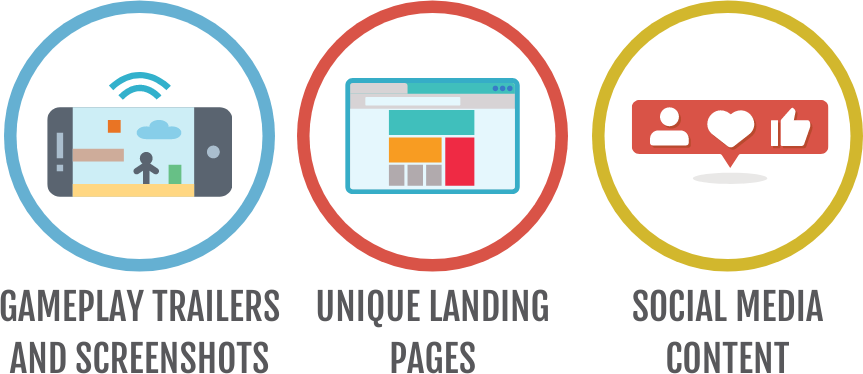Mobile devices have made it easy to game anytime, anywhere. Considering that 88% of time spent on mobile devices is used within apps, it’s clear that users love having access to such a wide variety of options.
The popularity of mobile gaming reached new heights during the COVID-19 pandemic. Users hit a record-breaking 1.2 billion weekly mobile game downloads in the first week of Q2 2020, sustaining an average of 1 billion downloads throughout the remaining quarter. This 20% year-over-year increase not only tracks with the strong demand for entertainment while users have been stuck indoors throughout the pandemic, but it also serves as a testament to the enduring popularity of mobile gaming.
Although games account for 33% of mobile app installs, standing out in the crowded app ecosystem can be an enormous challenge. Apple’s App Store boasts 1.96 million apps available for iOS devices, and the Google Play store contains nearly 3 million options. From well-established franchises to scrappy indie upstarts, gaining ground as a game in a bustling marketplace requires concentrated, sustained efforts to build and maintain an audience.
Since the inception of mobile app stores, app developers have voiced concerns over the many difficulties surrounding app discovery. More than half of app downloads are said to stem from App Store searches, and 34% of app shoppers go straight to top-rated categories and sort by the most popular options. This approach may offer users a glimpse into what’s trending among the most popular and well-established apps, but it can be difficult for an upstart or new release to crack into the first few pages of entries.
A proper digital marketing strategy is essential for mobile games seeking to reach audiences in crowded marketplaces. Without taking the right approach to attaining new users or building relationships with existing ones, even your most well-designed and thrilling mobile experience can wither away without a devoted base of fans.
But when it comes to attracting, engaging, and retaining users, determining which approach is best may seem like a daunting challenge. From display ads to email marketing campaigns, there’s no shortage of options that makes it possible to connect with audiences throughout the globe. Which of these strategies will ultimately help you earn the high score?
Target the right audiences with targeted marketing
One of the best digital approaches available today is through targeted advertising. Based on your user’s specific traits, interests, and preferences, targeted advertising crafts unique messages that are intended to reach ideal recipients who are more likely to perform a particular action, like downloading a game. Rather than relying on a static marketing campaign that casts a broad net, targeted advertising focuses on attracting the right audience based on their typical behavior.
The audience for a high-octane action shooter, for instance, might not be the same as that of a quirky, casual sudoku puzzle. But in another instance, an action title geared towards puzzle players might have a significant amount of crossover appeal and demand marketing efforts on both sides. A finely tuned approach to reaching the right customer at the right time can help ensure that your game finds the right audience — and the right audience finds your game.
Targeted marketing uses personalization to deliver content to the right user. According to a survey by Google, 90% of leading marketers believe that personalization significantly contributes to business profitability. Because 91% of consumers are more likely to engage with brands that offer relevant, personalized options, it’s no wonder that 89% of digital businesses are making investments in personalization — it’s the cheat code for reaching the right audience.
Developing a highly personalized targeted marketing campaign takes a significant amount of time, research, and effort. Just as you can’t run before learning to walk, releasing a slew of digital ads onto the internet won’t be effective without careful thought, planning, and attention. But by fully understanding a potential audience and crafting messages that are more likely to elicit a response, new and old games alike can garner the attention and revenue necessary for long-term success.
Key Elements of Crafting a Targeted Advertising Campaign
Step 1: Conduct Marketing Research

To begin targeting the right audience for your mobile game, it’s important to conduct proper market research. Due to the highly personalized nature of targeted advertising, having a strong grasp of who makes up your existing or prospective audience can help determine the success of your campaign.
There are a variety of different ways through which market research can be conducted by actively engaging with users, such as interviews, focus groups, or surveys. Any of these options can be tailored to elicit the type of information necessary to make better marketing decisions. For instance, a simple survey of existing players can help determine existing demographics. For broader questions, such as those that address potential new features or upcoming game releases, interviews and focus groups can help developers and digital marketers alike gain important feedback over what’s most important about the product.
When enough initial information about audiences has been gathered through traditional market research, conducting target market analysis can help pinpoint the finer demographics worth targeting. Digging deeper into the personal aspects of each potential customer can establish which type of customer is more likely to consider downloading your game.
This deep dive can include everything from basic demographic information — such as a user’s age, gender, education level, or occupation — to interests and habits, such as individual hobbies or purchasing patterns. Target market analysis can also include geography, which can be helpful in determining worldwide market potential, as well as the specific devices or platforms your users prefer to engage with.
Finally, market research should also include strategic competitor analysis. Because the app marketplace is so crowded, having a clear understanding of games likely targeting similar audiences can help find important points of differentiation for marketing campaigns. Even if two titles may seem similar, different aspects of the user experience, revenue models, or integrations with social gaming platforms can help your game stand out from the competition.
Key Takeaway:
Conduct market research of existing users, ideal users, and competitors in order to determine the audience you’d like to target for your game.
Step 2: Craft Personas
Armed with a clear understanding of audience factors and marketplace conditions, it’s time to undergo one of the most crucial steps towards developing targeted advertising campaigns: building personas. Crafted as a fictional representation of an ideal customer, personas help brands hone in on top marketing prospects.
Personas can be created using a wide variety of attributes drawn from internal usage statistics, market trends, market research, and sales figures. Acting as something of a composite sketch, personas can detail the fictional backgrounds, demographics, identifiers, and desires of each of your ideal customers. Depending on the game, any number of personas can be crafted in order to reach the best possible audience.
Here are a few sample personas that incorporate a wide variety of pertinent interests, personalities, and purchasing habits:

Example Ed is a 22-year-old recent college graduate. Ed listens to indie pop, loves horror movies, and loves making TikTok videos. He’s without much disposable income but loves playing turn-based role-playing games. He’d be open to paying for a game that all of his friends use, but for now, he sticks with options that are free to play.

Fake Frances is a 63-year-old retired teacher. Frances enjoys classic rock, documentary films, and staying in touch with her family over Facebook. She’s got a lot of spare time on her hands and loves to pass the time with relaxing, easy-to-play word and puzzle games. Frances isn’t a Luddite, but she’s not adept at navigating technology and finds the iOS App Store, in-app purchases, and subscriptions rather confusing.

Sample Steve is a 34-year-old engineer. Steve streams lots of vintage soul music, enjoys true crime podcasts, and lives on Twitter. Although he loves to game, his work and family life doesn’t leave him with very much free time. He tries to squeeze in gaming sessions on the subway to and from work, and because his leisure time is limited, he prefers to stick with classics he already knows and loves.
These are just three examples, but they extrapolate three very different types of players with widely varying gaming preferences and levels of purchasing power. Taken together, your company can craft marketing materials for a targeted advertising campaign that are directed towards any or all of these specific audiences.
Personas aren’t just limited to ideal customers, either. Anti-personas can be developed to help weed out the types of customers that aren’t ideal audiences for your game. By taking time to precisely determine the targets that are most (and least) likely to be receptive to marketing about your game, effective communications can be crafted to ensure that precious screen real estate isn’t wasted on a disinterested party.
Key Takeaway:
Build comprehensive and realistic user personas to serve as your ideal marketing targets.
Step 3: Create Great Content
With an army of carefully sculpted personas, it’s time to start creating compelling marketing content. The quality of a game may seem to speak for itself, but quality content can help guide users unacquainted with the title towards making a download.
Because the internet is awash with all types of content, it’s important to create content that personas are most likely to respond to. Personas that seem attuned to the latest-and-greatest games may feel more compelled to follow a link to a collection of positive reviews, whereas another persona looking to play something new and exciting right away may prefer to be guided directly to a download link in an App Store.
Although game creators can create any number of different pieces of content, here are some easy-to-create options that leverage what’s already been made for your game:
- Multiple gameplay trailers and screenshots: App stores highlight the best the game might have to offer, but personas may be drawn towards different aspects of the gaming experience. Cutting new trailers that demonstrate specific aspects of your game, as well as capturing screenshots that highlight the same types of experiences, can help tell the best possible story for each persona.
- Unique landing pages: Whether it’s built using a mix of reviews, screenshots, videos, or other pieces of content, unique landing pages can be crafted for each persona to explore. When distributing marketing communications or running display ads, these unique landing pages can be attuned to your persona’s specific interests and ensure that they see content that’s highly relevant.
- Interviews, influencers, and other social content: Gaming is a wide-reaching industry that has fans of all ages and life experiences. Because the social component of gaming is so deeply embedded into the industry, it’s important to embrace its community aspect. From developer interviews to Twitch streams, fostering unique content that’s easily accessible for each persona can help a gaming experience become part of an important social trend.

That’s not to say that articles, podcasts, YouTube videos, or other pieces of content don’t play an important role. All high-quality mentions or examples of a game can be the Easter eggs that help convert personas into paying customers.
Key Takeaway:
Create or repurpose existing content specific to each persona.
Step 4: Launch Personalized Display Ads
Now that you’ve completed your market research, created personas, and crafted high-quality content, your targeted marketing campaign is ready to launch. Because of the significant amount of effort placed into understanding potential users, launching display ad campaigns should feel like a natural extension of the work already completed.
Display ads should be targeted towards your game’s desired personas. In addition to creating an appropriate call-to-action that matches each persona, the target of the ad should guide the user towards the most appropriate type of content. Whether it’s a direct link to download the game, a landing page filled with persona-specific content, or a Twitch stream by an influencer, these ads should guide the user towards an experience that appears to be highly relevant.
Because ad networks like Facebook and Google include comprehensive tools for targeting specific demographics and interests, it’s okay to fine-tune display ad campaigns as much as necessary. A-B testing also makes it possible to see which ads have the most effective performance, allowing your team to test multiple messages in order to determine which is best.
Key Takeaway:
Run personalized display ad campaigns that guide personas towards specifically-crafted content.
Targeted Advertising: Good Ads, Great Content, Greater Downloads
No matter the persona, targeted advertising must serve as the bridge to quality content. Tapping on an ad that’s been personalized for a particular persona only to land on an irrelevant page creates a negative user experience that reflects poorly on your game. If the sheer number of personas worth targeting seems daunting at first, it’s okay to start slow and reach the most ideal customers first before expanding into wider audiences.
Even though there are millions of apps available, it only takes one killer experience to shoot a mobile game to the top of the charts. By clearly defining your game’s audience, crafting relevant content, and guiding users towards making a download using personalized display ads, any game can be given a true shot at earning a permanent spot on the home screen.

